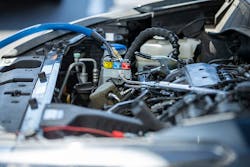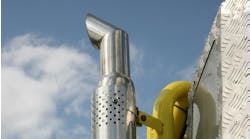Guest Blog: Walnut shell blasting versus 3C Intelligent Induction Cleaner
Gasoline direct injection (GDI) engines are efficient, pack a lot of power for the relatively small size, and run cleaner than earlier port fuel injected engines. The difference in design is denoted in the name; early engines were port fuel injected, fuel is injected into an intake port, flowing past the back of the intake valve to atomize and burn once inside the cylinder. Modern direct injection engines spray fuel directly into the combustion chamber, bypassing the port and valve, to atomize inside the cylinder, where the fuel is burned. The relocation of the fuel injector and how the fuel is utilized is where all the gains come from.
Let’s back up one moment and look at one benefit port fuel injection offered that direct injection does not.
Port fuel injection keeps the intake ports and intake valves clean during engine operation. Gasoline direct injection (GDI) engines lack the built-in cleaning properties of port fuel injected engines. What that means for vehicle owners and mechanics alike is that the intake ports and valves on GDI engines have to be regularly cleaned to maintain engine drivability and fuel economy. If carbon is allowed to build up, even small amounts will cause engine performance to suffer. Fuel economy will drop and eventually your engine will misfire. Think of it as the carbon choking the airways of your engine.
Carbon deposits build up on the back of intake valves and inside the intake ports, and without the port fuel injection fuel spray cleaning them, it’s up to the vehicle owner to keep the deposits from building up and causing engine issues. This can be done a few different ways, but the best way to manage carbon buildup is with preventive maintenance. This means being proactive and cleaning carbon build-up before it chokes your engine. This preventive maintenance can be done with the 3C Carbon Cleaning System.
So, how can the carbon build-up be removed?
Maintenance is the best way to prevent carbon build-up from causing engine drivability problems, no question about it. Depending on your choice method of cleaning carbon, there are benefits to each as well as caveats.
Traditional carbon cleaning methods are done with manual removal (by hand and tool) and also by using a walnut shell blasting machine. Both require the engine intake manifold to be removed, a time consuming repair on its own, as well as risky due to the chance of disturbing fragile engine components.
Often times when removing the intake manifold, a fuel injector or two will be stuck in the cylinder head, these are difficult to remove when stuck.
You will always need to replace all of the seals and gaskets, and sometimes you will need to replace the fasteners as well as brittle electrical connectors or plastic vapor lines.
With that said, sometimes using walnut shell blasting or cleaning carbon manually is the only acceptable method due to engine design.
A few other important points about walnut shell blasting:
- Some intake designs are not conducive to walnut cleaning. Walnut shells can become trapped and interfere often unnoticed before assembly and restart. Catastrophic damage may be the result.
- Proper knowledge of walnut cleaning is necessary. Spend careful attention to close each valve so walnuts do not fall down into the cylinder. This situation will also cause irreparable damage.
- Sometimes it is the only way due to engine design or manufacturer specification. Be prepared for all scenarios when going in.
What other options are there?
Manually cleaning by hand or by soaking with chemicals offer no time benefit (when compared to walnut shell blasting) and are less effective. Some of these chemicals can be harsh and destructive to rubber seals on the valve stem and other surrounding components.
Non-intrusive chemical cleaning removes all the associated risks of engine tear down, manual scrubbing, and unforeseen repairs resulting in intake removal. Until now, there hasn’t been a system that could actually clean carbon build-up from the back of intake valves. The 3C Intelligent Induction Cleaner (IIC) uses triple chemical layering, delivered by micro-burst and air injection technology to more effectively remove carbon build-up from engines.
The ATS 3C IIC system saves time and money for both the shop and the vehicle owner while helping to maintain the performance of GDI engines. The 3C carbon cleaning machine does not require engine disassembly (intake manifold removal). This means you won’t have the additional labor charge of the repair or the costs for parts and gaskets. With the intake manifold staying in place, you remove the risk of damaging fragile vapor and vent lines as well as plastic connectors and components.
3C makes quick work of carbon and cleans most cars in less than 15 minutes.Here’s how: the 3C Carbon Clean System connects to the engine via the purge valve vacuum line. Once connected, carbon is cleaned through a 3-step chemical cleaning process. All automated, all catalytic converter and engine safe. No soaking or manual scrubbing is needed, so seals and other rubber components are not affected during the cleaning.
The 3C cleans heavy carbon deposits, as well as helps to prevent carbon build-up. When the service is performed every 30,000 miles, carbon build-up is removed before it becomes a major problem.
Information provided by ATS Carbon Clean





